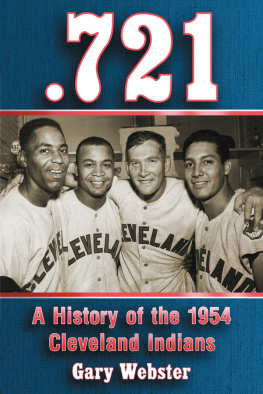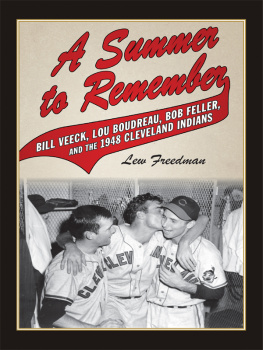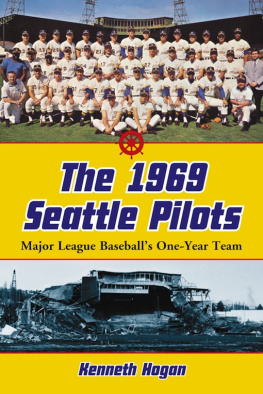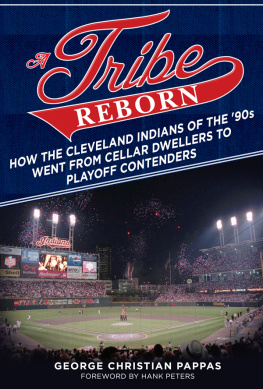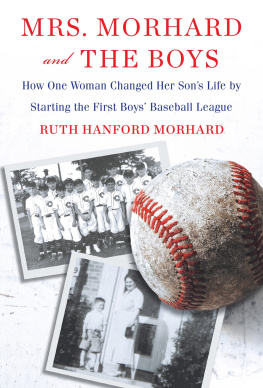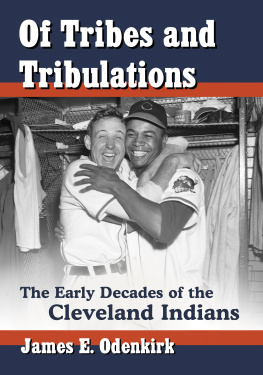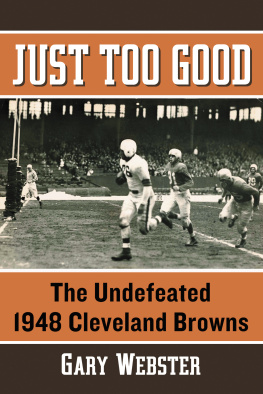
Also by Gary Webster
Tris Speaker and the 1920 Indians:
Tragedy to Glory (McFarland, 2012)
.721
A History of the 1954 Cleveland Indians
Gary Webster

McFarland & Company, Inc., Publishers
Jefferson, North Carolina, and London
LIBRARY OF CONGRESS CATALOGUING DATA ARE AVAILABLE
BRITISH LIBRARY CATALOGUING DATA ARE AVAILABLE
e-ISBN: 978-1-4766-0562-3
2013 Gary Webster. All rights reserved
No part of this book may be reproduced or transmitted in any form or by any means, electronic or mechanical, including photocopying or recording, or by any information storage and retrieval system, without permission in writing from the publisher.
On the cover: (left to right) Cleveland players Larry Doby, Al Smith, Hal Newhouser and Bobby Avila in 1954 (Cleveland State University)
McFarland & Company, Inc., Publishers
Box 611, Jefferson, North Carolina 28640
www.mcfarlandpub.com
Preface
When the topic of conversation among baseball fans turns to the greatest individual teams of all time, there are some conspicuous absences.
One is the 1906 Chicago Cubs, who still hold the sports record for highest winning percentage with a staggering .763. Even though those Cubs boasted four Hall of Famers in shortstop Joe Tinker, second baseman Johnny Evers, rst baseman (and manager) Frank Chance, and pitcher Mordecai (Three Finger) Brown and won 116 games while dropping just 36, they blew their chance to be considered the best team ever by losing the World Series to the cross-town Hitless Wonders White Sox, who somehow managed to win the American League pennant despite a pathetic .230 team batting average. A season for the ages went down the drain in six October afternoons.
The 2001 Seattle Mariners laid waste to the American Leagues West Division, matching the Cubs record of 116 victories and seemingly clinching the division title sometime around the Fourth of July. Little more than a decade has passed since manager Lou Piniellas crew established the league record for wins in a single season, but theyre barely an afterthought when fans argue about the best teams ever. The Mariners struggled to win their Division Series against the Cleveland Indians in ve games and were eliminated from the League Championship Series in six games by the New York Yankees. A team that didnt even reach the World Series, regardless of how many games it won during the regular season, doesnt gure in the debate over the best team of all time.
When was the last time anyone mentioned the 1969 Baltimore Orioles, who breezed to the rst-ever American League East Division title with 109 victories and then attened the Minnesota Twins in three straight games in the League Championship Series? The 1969 Orioles are only remembered as the team the Miracle Mets defeated in the World Series. And no one ever thinks of the Miracle Mets as the greatest team ever. Except maybe overly enthusiastic Mets fans.
To be considered the best team in the history of a professional sport, a team must have won that sports championship, explaining why the 1954 Indians nd themselves in the company of the 1906 Cubs, the 2001 Mariners and the 1969 Orioles, among others, when fans debate which team was the best in major league history. All were big winners during the regular season and big busts in the post-season, whether that post-season consisted only of the World Series or todays multi-tiered playoff system.
Clevelanders should look back with pride on the accomplishments of their 1954 Indians, whose 111 victories remains the franchise record and was the American League record for 44 years, until the Yankees eclipsed it with 114 wins in 1998. The 1927 Yankees record of 110 regular season victories stood for only 27 years. The 1954 Tribes .721 winning percentage is still the leagues all-time best. The Indians snapped the Yankees streak of ve consecutive pennants and denied Casey Stengels only team to win 100 or more games a ag. The Indians rode the right arms of Bob Lemon, Early Wynn and Mike Garcia, still one of the best starting pitching staffs ever assembled, and boasted of the American League batting champion in second baseman Bob Avila. What Clevelanders remember, however, is how their seemingly invincible Indians were humiliated in the World Series by the New York Giants, failing to win even a single game. The Tribe wouldnt win another pennant for 41 years.
How did it happen?
A study of the statistics indicates the Indians were a classic example of a team that was greater than the sum of its parts. Despite a roster which included ve future Hall of Famers, the 1954 Indians wouldnt be confused with the 1927 Yankees fabled Murderers Row. In his declining years, Tribe Hall of Famer Bob Feller, who won 13 games as a spot starter in 1954, insisted that the 1948 World Series champion Indians were a much better team and the collapse against the Giants shouldnt have been as startling as it was. Other players suggested that manager Al Lopez was obsessed with breaking the 1927 Yankees record and drove the team too hard to achieve that goal, leaving them exhausted at seasons end and rendering the World Series anti-climactic. Maybe they slumped at the worst possible time, as Lopez suggested. Or maybe the Giants were a better team.
I dont claim that this book will uncover reasons for the Indians World Series swoon that has bafed baseball historians for nearly 60 years. But it will tell the story of a talented team whose accomplishments deserve better than to be relegated to the dumpster of history.
Hank and Al
An American League baseball team has called Cleveland, Ohio, its home since the circuit was born in 1900. A lot of players, managers, coaches and executives have been associated with the franchise in that time, but few, if any, have been as controversial, and as polarizing, as Hank Greenberg. And few, if any, have been as underappreciated as Al Lopez.
Greenberg joined the Indians three weeks before the clubs magical journey to the 1948 World Series championship began. Greenberg reportedly invested $100,000 in the team and was given the title of second vice president by owner Bill Veeck. Veecks rst vice president, Harry Grabiner, had been part of the original ownership group that purchased the Indians in June of 1946. Because Greenberg, who had been released by the Pittsburgh Pirates after the 1947 season but hadnt ofcially retired, had been working out with the Indians in Tucson, Arizona, there was speculation that he planned to continue his career in Cleveland. Greenberg did nothing to discourage that speculation.
I dont want the players to get the idea that I am going to beat anybody out of a job, said the former Detroit Tigers slugger who had slammed 58 home runs in 1938. Im going to stay in condition and if they need me, Ill play. I would hate to tell you anything denite about my playing status at this time because I might change my mind tomorrow. All I can say is this: as long as Im able I will help out in the eld in some capacity, even if it is collecting the balls during batting practice.
Asked if he might serve as a coach, Greenberg answered, I think the purpose of this club or any club is to win the pennant. If my coaching will help, then Ill do it. Greenberg said he was interested in joining Veecks group when he heard the Indians were available in 1946, but wasnt ready to retire as a player. Since I left the Tigers, though, Ive been looking for something just like this. I like the Cleveland club very much. Naturally, I wouldnt be buying into it if I didnt. Its a good ball club and I think we have a chance for the pennant.
Next page

